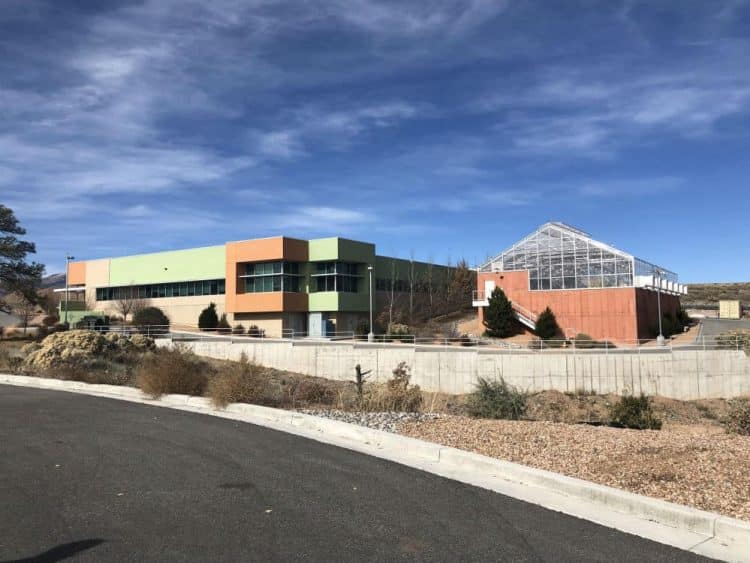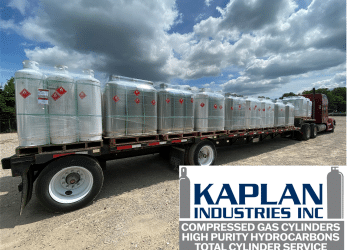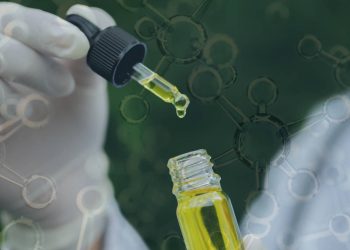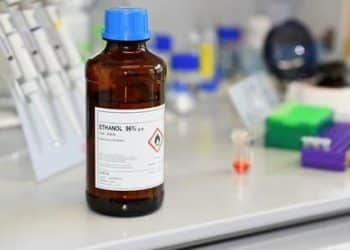There’s strong motivation to make cannabis beverages and other products that provide non-oil based delivery systems. But as you well know, cannabinoids love fats, not water. And drinking fats never seems like a logical solution. Some companies have opted to create nano-emulsifications to transform hydrophobic molecules like THC into hydrophilic derivatives. Trait Biosciences opted to look to the natural world for guidance. We were fortunate enough to connect with Ronan Levy, Chief Strategy Officer of Trait Biosciences.
T&T: First off, tell us about Trait Biosciences. How did it begin? How did you find yourself in the cannabis industry?
Levy: Trait is the result of what happens when you give some of the best and brightest minds in the plant sciences sector a challenge: to increase yields in the hemp and cannabis industries and make those plants and resultant products as pure and safe as possible for consumers.
Our Chief Science Officer, Dr. Richard Sayre, who was a Level 6 scientist at Los Alamos National Laboratories at the time (and, who has been recognized by the journal Nature as 1 of 5 crop scientists “who could change the world”), took up the challenge. He realized that by using a process that’s ubiquitous in nature (and often in the pharmaceutical sector) – a process called glycosylation – we could detoxify the process of synthesizing cannabinoids such as THC and CBD in hemp and cannabis. By getting the plant to glycosylate cannabinoids (which involves attaching a glucose molecule to the cannabinoid), we could increase yields by between 2x and 10x, orders of magnitude more than conventional plants.
From those inauspicious beginnings less than 2 years ago, we have created a 24-member scientific team in Los Alamos that has built 5 platform technologies that will be necessary to succeed in this market through greater productivity and safer products. Our rate of innovation is also remarkable – we are literally creating or obtaining a game-changing patent every month.
T&T: I can remember when mango was the new fruit added in to everything. Then pomegranate. And kale. Now, CBD is ubiquitous. What should consumers be weary of? What would you suggest the average cannabis consumer consider when forming their own opinion or purchasing products?
Levy: We’ve described CBD as the “new Frank’s Red-Hot Sauce” because it seems everyone is trying to “put that sh*t on everything” these days. From a health perspective, this is not necessarily a terrible idea; there seem to be many potential positive therapeutic characteristics of CBD. From a business perspective, it also has many potential positive aspects as businesses will be forced to innovate products and formulations that leverage the many possible uses of CBD.
From a consumer perspective, I think the biggest risk is that most products containing CBD in the United States are unregulated and so product safety is a question. As a result, people should make sure to only purchase products from brands and companies that they trust and that produce with good manufacturing practices.
From a clinical perspective, there do appear to be many positive therapeutic uses of CBD, from treating epilepsy to reducing anxiety to managing chronic pain. However, most of these benefits are only anecdotal and, because of the regulatory grey zone that CBD has operated in for so long, there aren’t many high-quality studies that can confirm these claims, yet.
T&T: The motivation behind manufacturing many cannabis products stems from the desire to create customized formulations. How do you see customized formulations evolving in the industry, when there’s nearly 300 cannabinoids and terpenes in the plant? What method(s) of obtaining these minor cannabinoids do you anticipate really coming into the forefront of the industry? Some people have hypothesized that the future of the industry will have nothing to do with growing the plant, but rather, yeast or bacteria will be used to biologically manufacturer the starting cannabinoids.
Levy: We expect there to be heavy investment in formulations for products derived from cannabis and hemp. The biggest knock on most products that exist right now is the lack of predictability of experience – from onset to actual feeling and effect. As more research is conducted on cannabinoids, we expect that tailored formulations will result in more predictable experiences, which will be good for everyone.
However, we think the current interest in yeast or bacteria as a means to produce cannabinoids will not sustain. The reason for this is simple: the hemp/cannabis plant has evolved over hundreds of thousands (if not more) years and is very efficient at producing cannabinoids. In order to get yeast or other bacteria to produce cannabinoids, you need to rebuild all of the relevant genetic pathways into the yeast/bacteria, even at a microscale. This is why, even though the work done by the research team at UC Berkeley was interesting, the plant as it is today can produce cannabinoids with 10,000x the concentrations that yeast might achieve because the plant already has the necessary machinery and infrastructure to produce all cannabinoids.
This is why our work at Trait is focused instead on optimizing and expanding what the plant can do. For instance, our Trait Amplified technology creates the glycosylated cannabinoids in the plant. Because glycosylated cannabinoids are water-soluble (as opposed to conventional cannabinoids, which are fat-soluble), the onset time of glycosylated cannabinoids will be faster and more predictable than conventional cannabinoids. Also, from a product perspective, water-soluble cannabinoids can greatly simplify the manufacturing process by eliminating the need for high-intensity extractions that use toxic solvents such as butane, as well as emulsifiers and nanotechnologies, the latter of which raises serious health concerns.
T&T: Can you explain how the process of making fat-loving cannabinoids water-soluble works?
Levy: By their nature, cannabinoids are fat-soluble, which means that they don’t dissolve into water, but rather only dissolve into fat. This is why companies need to use high-intensity extraction processes to remove the cannabinoids from the plant, and also why many cannabis products come as oils. As anyone who has ever used salad dressing can observe, oil and water don’t mix. This is why it’s challenging for many companies to produce high-quality, visually appealing, safe, predictable, and good tasting cannabis beverages.
The process we use in Trait Distilled and Trait Amplified is glycosylation, which is a natural process by which a sugar molecule is added to another molecule. It’s so natural, in fact, that our bodies glycosylate the cannabinoids we ingest! This happens in the liver as part of the metabolism process, and our body does it in order to water-solubilize the cannabinoid.
Our process simply glycosylates the cannabinoid before we ingest it. The advantages of glycosylating cannabinoids in advance of ingestion are many: (1) it makes it easier to mix cannabinoids into edibles and beverages and improves product shelf-life; (2) it eliminates the need to use solvents or high-intensity extraction processes to isolate cannabinoids; with our Trait Amplified technology, the cannabinoids can be pressed and juiced out of cannabis much like sugar is pressed and juiced out of sugarcane; (3) it eliminates the need for nanotechnologies or other emulsifiers in cannabis products which, as mentioned, raise various health concerns; and (4) water-soluble cannabinoids will have a much faster onset and more predictable experience than fat-soluble cannabinoids which have to travel much further down the digestive track before being metabolized.
T&T: Does the process by which cannabinoids are converted to water-soluble species also work on terpenes?
Levy: Yes, our technology can be used to attach a glucose molecule to just about any cannabinoid or terpene from the plant.
T&T: You mentioned nanotechnology, and potential health risks. Could you expand upon this in more depth?
Levy: Nanotechnologies, and nanoemulsions in particular, are being used by some companies to create cannabis beverages and edibles. Nanotechnologies use emulsifiers that exist on a nano-scale (being less than 100 nanometers in size). Nanotechnology is considered risky because the interactions between nanoparticles and biological systems are poorly understood, and there is growing evidence that nanoparticles can have negative health impacts. For instance, there is evidence that because nanoparticles are so small, they can cross into parts of the body that are otherwise protected, resulting in potential brain damage, immune system disruption, toxicity to organs and tissue through bioaccumulation, DNA damage and cytotoxicity.
These risks, particularly associated with the brain, are increased by the fact that many cannabinoids are psychoactive and/or psychotropic. Increased risks can occur because nanoemulsified cannabinoids can pass through the blood-brain barrier with greater efficiency, thus significantly magnifying the effects of the cannabinoids in the brain.
T&T: How do you see this industry 1 to 2 years from now? What’s on the frontier? Can Big Pharma compete with cannabis-derived formulations?
Levy: The cannabis industry is still very much in its infancy and there is plenty of growth and excitement to come. Over the next two years, the focus is going to be in three areas:
(1) Successfully operationalizing and bringing efficiencies to large scale production facilities. Although people have been growing cannabis for thousands of years, we are only now witnessing the first real efforts to bring standard operating practices to enhance cultivation practices of this ancient plant and there are many lessons to be learned. Further, as cannabis and cannabinoids are likely to be commoditized, there will be tremendous efforts put into increasing yields and bringing down the cost of production. This is why we are so excited by the potential of Trait Amplified, which significantly increases yields, as well as Trait Defense, which protects the plants from common pests and plant diseases without the use of chemical pesticides or fungicides.
(2) There will be significant investment into formulations and predictable and tailored experiences. As progress moves forward in this respect, we expect that Big Pharma will start to make active investments in the industry, which we think they would be smart to do. Although many people see the cannabis industry as a competitor to the alcohol industry, we expect it will also take a big chunk from traditional pharmaceuticals as health and wellness continues to trend toward effective, natural solutions. As cannabinoids may have therapeutic benefits for a host of conditions from pain to epilepsy to anxiety, among others, pharmaceuticals would be wise to look at investing in the industry and participating in its growth and evolution, as opposed to competing with it head on.
(3) Consumers safety will also be a major factor of success in the market. Today many cannabis and hemp products currently do not pass regulatory standards — they have too much mold or other toxins such as herbicides or pesticides. As the industry matures, and regulators clarify standards, those that succeed in the market will be brands that guarantee purity and safety.
T&T: What makes you excited to be involved in this nascent industry?
Levy: We love being part of the industry. We have put together a global team of scientists that are creating technologies that will make cannabis and hemp products safer and purer. Beyond the entrepreneurial, business and scientific challenges of this rapidly growing market, the potential for good that the cannabis industry can create in the world is remarkable. From helping alleviate suffering, to expanding consciousness, to displacing the very damaging prevalence of alcohol in our society (the public health costs of alcohol are astonishing), we believe the re-emergence of cannabis in our society will bring a world of good.












